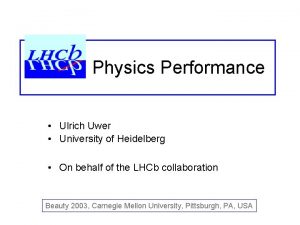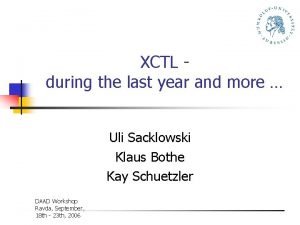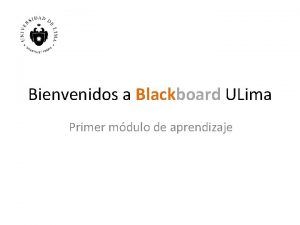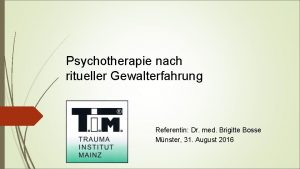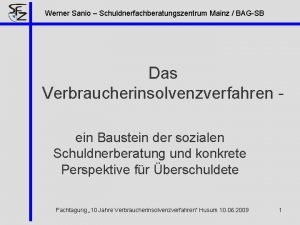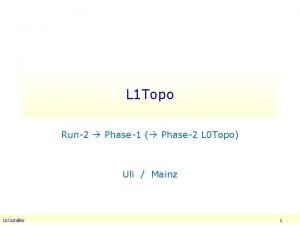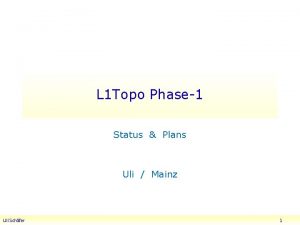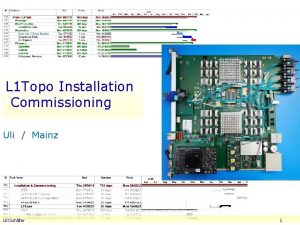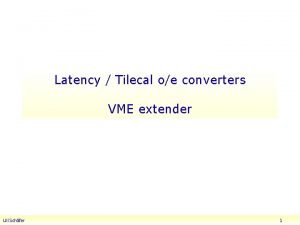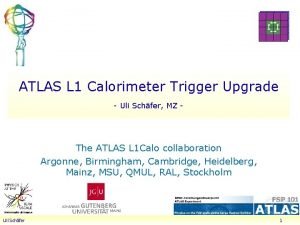LTopo Run2 Phase1 Phase2 Uli Mainz Uli Schfer













- Slides: 13

L*Topo Run-2 Phase-1 Phase-2 Uli / Mainz Uli Schäfer 1

L 1 Topo in its habitat Uli Schäfer 2

L 1 Topo / run 2 Uli Schäfer 3

L 1 Topo / Run-2 module control real-time path algorithms CTP readout / embedded ROD • five modules built for run 2 • two algorithmic processors • one DAQ/control FPGA • designed for phase-1/phase-2 compatibility • two modules deployed at point 1 Uli Schäfer 4

L 1 Topo unplugged Uli Schäfer 5

L 1 Topo floor plan / run-2 o/e Real-time path CMX/µ ATCA zone 3 Readout S-Link zone 2 mezzanine real-time path CTP (electrical) Uli Schäfer e/o 6

L 1 Topo phase 1 • New L 1 Topo production for phase 1 • 3 new modules were initially planned for phase 1 • 2 × topology • 1 × hit merger for L 1 Calo multiplicity triggers • Current L 1 Topo can act as a prototype: • Existent modules expected match needs for Phase-1 • No changes to concept • Will need to run new PCB production anyway • Will allow for improvements / adaptation to upcoming phase-2 requirements • Expected to live in an ATCA water cooled “standard” shelf • Space • Power / cooling Uli Schäfer 7

L 1 Topo floor plan / phase-1 o/e activate inter. FPGA links add optical realtime path To CTP Real-time path FEXes/µ ATCA zone 3 zone 2 mezzanine Uli Schäfer DAQ/ROI via L 1 Calo ROD/HUB electrical 8

Summary: Modifications wrt run-2 • Connect to L 1 Calo hub/ROD modules via backplane • Requires different extension mezzanine • Basically route-through of 16 high-speed signals • DAQ/ROI • Clock / TTC data • Switch-on inter-processor communication • Signals duplicated between FPGAs rather than forward duplication upstream • Adds bandwidth for incoming signals • Latency: be prepared to continue duplicating a fraction of signals upstream. The ones on latency critical path… • Add output bandwidth for signals into CTP • Optical link • No plan to remove electrical link (latency ? ) • One possible modification under consideration already now: • We might prefer the CERN recommended jitter cleaner (used on j. FEX prototype) over the one used on L 1 Topo Uli Schäfer 9

Needs / changes for phase-2 … • • as known by now Challenging processing: more/complex algorithms Fortunately less stringent latency requirements Far less duplication of resources required Time multiplexing might be possible • Plus the need to supply ROIs to “Regional Readout Request” (R 3) logic • Near real-time • Latency approximately on the same scale as L 0 trigger • Will not be possible through the backplane / L*Calo hub/ROD modules • ROIs basically TOBs that fired topo algorithms • … how many ? Uli Schäfer 10

L 0 Topo floor plan / phase-2 o/e Real-time path FEXes/µ inter-FPGA links real-time to CTP near-real-time to R 3 module total: 24 × 12 Gb/s ATCA zone 3 zone 2 mezzanine To ROD/HUB Uli Schäfer 11

Summary of changes for phase-2 • Optical output bandwidth needs to be shared between L 0 and R 3 data • Total bandwidth available per module : 24 * ~10 Gb/s • Algorithmic firmware will need to be modified to address • Need for complex algorithms • Need to identify TOBs that fired the triggers • Involves tagging / pipelining the TOBs such that at time of decision the information is still available • Route the TOBs / ROIs out to high-speed links In the light of two well-filled L 1 Topo modules in run-2: • The system is scalable • Standard ATCA crate has 12 slots available for processor blades • Will allow for additional modules to be installed Uli Schäfer 12

Summary / outlook / discussion • The L 1 Topo module concept will allow smooth transition run-2 / phase-1 / phase-2 • Hardware modifications will be possible • System is scalable, larger module count not ruled out • Upstream modules should allow for sufficient output bandwidth • Bandwidth for ROI data of ~200 Gb/s per module probably adequate ? • If not: need to understand now • Spare output bandwidth on processor FPGAs available • Need to be routed out to additional opto/electrical converters • Firmware will require major changes to benefit from increased latency and to support R 3 concept Uli Schäfer 13
